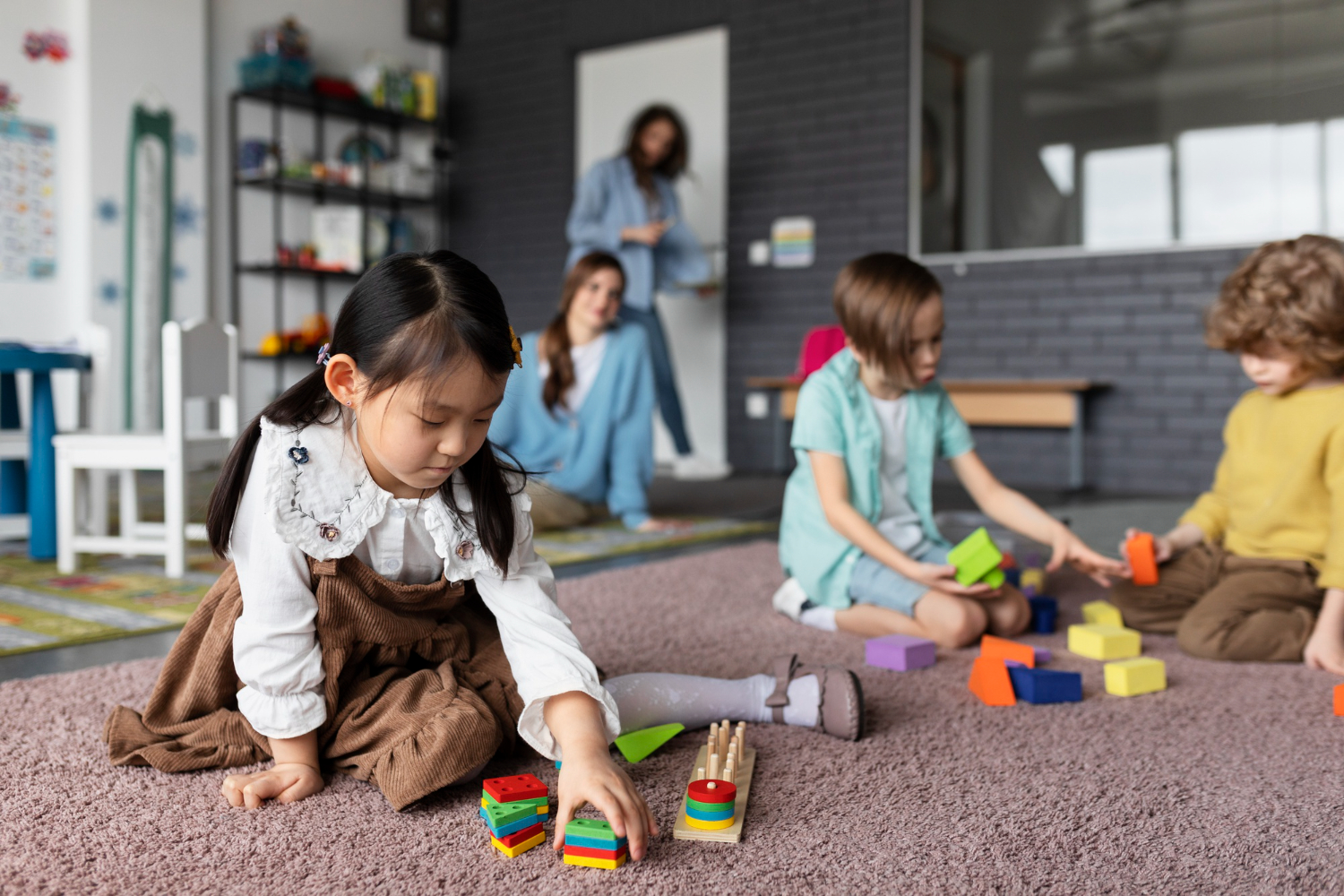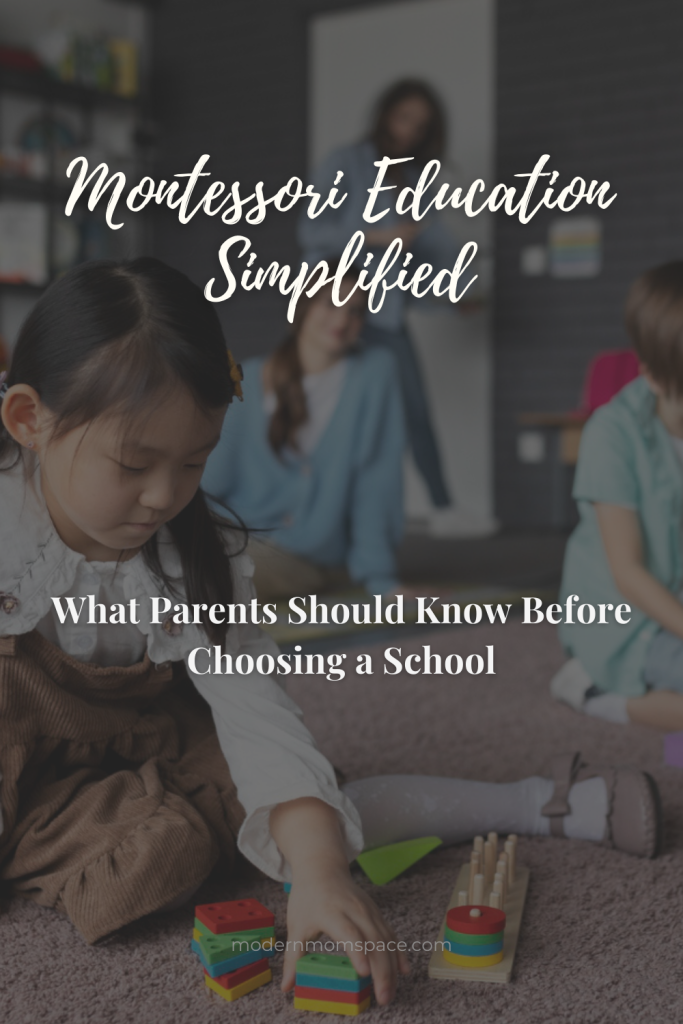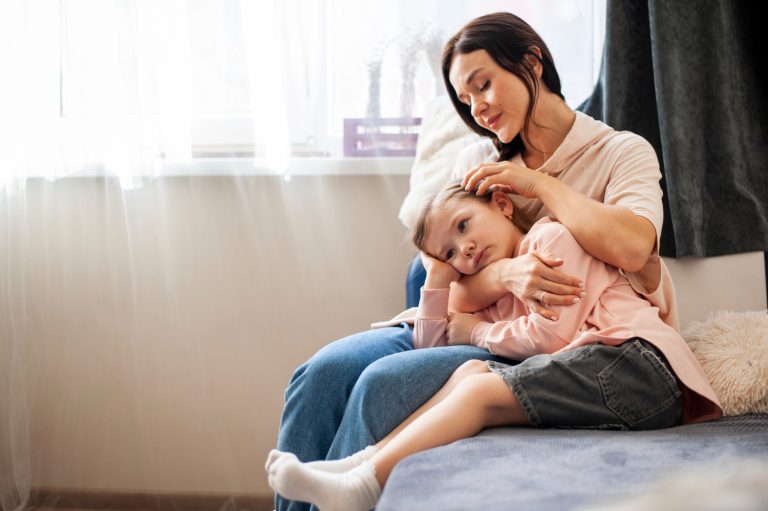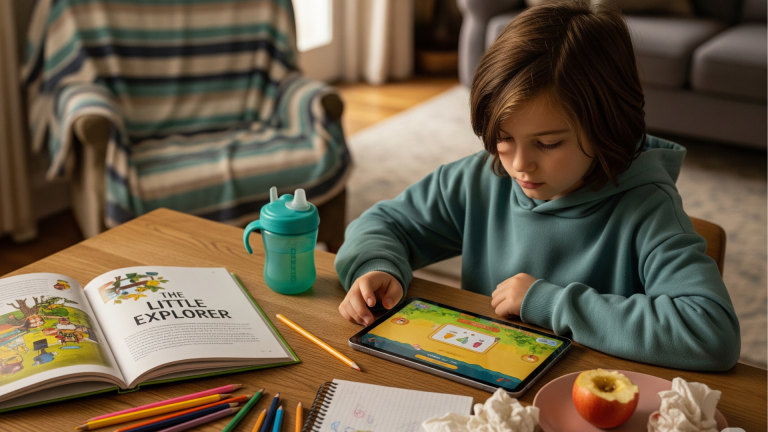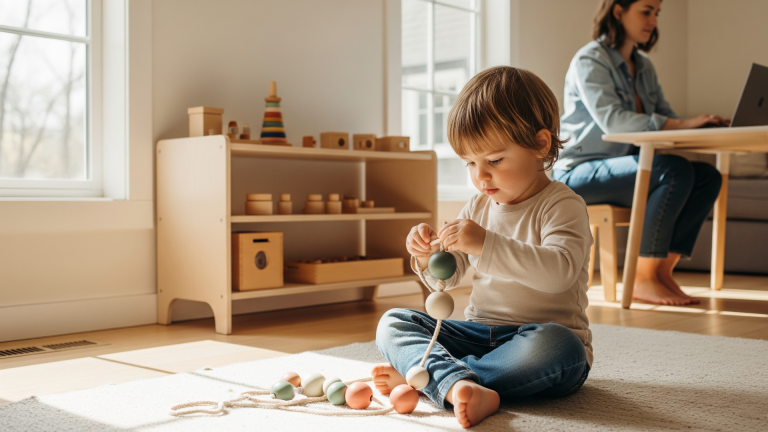What Is a Montessori School? A Practical Guide for Parents
Stop. If your mental picture of a Montessori school is kids running wild with wooden toys, throw that picture away. Montessori looks calm on the surface because it’s deliberate underneath — a prepared environment, not a free-for-all.
Fast Answer: What Is a Montessori School?
Short version: A Montessori school is a prepared learning environment where children choose teacher-presented, hands-on activities and move at their own pace. Teachers guide and observe rather than lecture.
Montessori method explained (in one line): It’s freedom within limits — mixed-age groups, long work blocks, and materials that move students from concrete experience to abstract thinking.
Montessori classroom examples (quick):
Why parents pick it: Builds concentration, independence, and practical skills that transfer to real learning. High-quality Montessori programs often match or outperform traditional approaches in early years.
Quick visit checklist (what you should see in 5 minutes):
Bottom line: Montessori is practical, focused on learning-by-doing, and not a “soft” alternative. If you want to know whether a specific Montessori school will deliver, use the checklist — and ask how they measure progress.
What Is a Montessori School? (Montessori Method Explained)
Imagine walking into a classroom where children of different ages are calmly engaged in different activities — some counting beads, others tracing letters, a few pouring water carefully from one jug to another. No bells ring to start or stop lessons. No teacher stands at the front giving instructions to everyone at once. It’s quiet. It’s purposeful. It looks different from any classroom you probably remember — and that’s exactly the point.
A Montessori school is a child-centered learning environment built around freedom within limits. Every element in the room — from the shelves to the materials — is deliberately designed to guide children toward independent learning. Mixed-age classrooms allow older children to mentor younger ones, reinforcing their own skills in the process. Teachers are guides and observers rather than traditional lecturers. Their role is to introduce new materials, demonstrate lessons, and step back to let students explore at their own pace.
Key Features of the Montessori Method
Quick reality check — Montessori isn’t “no rules” or “play all day.” Every freedom comes with structure: materials have a purpose, choices have limits, and independence is taught deliberately.
Practical tip for parents: When visiting a Montessori school, look for clear lesson sequences on shelves, calm engagement, and teachers guiding but not micromanaging. These small signals reveal whether the school truly follows the Montessori method.
How the Montessori Method Works in Practice
Step into a Montessori classroom and you’ll notice something immediately striking: it feels purposeful, but it isn’t rigid. Children are not following a strict schedule dictated by bells or lesson plans; instead, they move through the day guided by curiosity, interest, and mastery. This is the essence of the Montessori method in practice — a balance of freedom, structure, and intentional design.
Concrete to Abstract Learning
Montessori materials are never decorative — each has a learning goal. Concepts start concrete so children can physically manipulate objects before moving to abstract understanding.
This hands-on approach doesn’t just make concepts “easier” — it deeply embeds understanding, enabling children to answer “why” questions, not just “what.”
Think Montessori is all serious work? Not at all. A child carefully pouring water or threading beads is quietly developing coordination, focus, and patience — practical life skills that also strengthen brain function.
Long Work Periods Build Focus
Traditional classrooms often rotate students through 20–30 minute lessons. Montessori classrooms prioritize 2–3 hour uninterrupted work blocks, giving children space to:
During this time, teachers circulate, observing or gently guiding only when needed. The result? Children learn self-discipline and deep concentration, often for the first time in a structured environment that feels liberating rather than restrictive.
Mixed-Age Groups Encourage Peer Learning
Montessori classrooms typically group children in three-year spans (e.g., ages 3–6, 6–9). This structure creates a natural mentoring system:
Practical takeaway: If you’re a parent worried your child might fall behind, notice how students naturally progress at their own pace. Mastery — not speed — is the goal.
Practical Life Activities Teach Real Skills
Montessori classrooms integrate “life skills” into everyday learning. Tasks like tying shoelaces, pouring liquids, cleaning, and preparing snacks aren’t chores — they are learning experiences that develop:
These activities might seem minor, but they’re powerful. A child who can focus to pour water without spilling is practicing the same concentration and control needed for reading, writing, and math later.
Observation-Based Assessment
Forget grades or timed tests. In Montessori schools, teachers observe and document:
This portfolio approach gives a richer picture of learning than a letter grade ever could. Parents can see progress in real time through work samples, teacher notes, or portfolios — reinforcing that learning is individualized, not standardized.
Bottom line: The Montessori method works because it’s structured flexibility. Children explore, experiment, and master concepts at their own pace, guided by teachers who intervene only when necessary. It’s deliberate independence — the kind that builds lasting skills, curiosity, and confidence.
Montessori Classroom Examples
If you’ve ever wondered what a Montessori classroom actually looks like in action, here’s your chance to peek behind the shelves. These are real activities with real learning outcomes, not just toys scattered on a table.
Math
Practical takeaway: Concepts move from concrete manipulation to mental calculation, building deep understanding rather than memorization.
Language
It may look like simple tracing, but each movement builds phonemic awareness, writing skills, and confidence.
Science
Practical takeaway: Science is exploratory, not rote memorization. Kids are scientists, not spectators.
Practical Life
Why it matters: These tasks strengthen fine motor skills, concentration, patience, and responsibility. They also create independence that feeds academic focus.
Sensorial
Don’t assume Montessori is only “hands-on kids’ play.” Each material, each activity is deliberate. Every movement has a learning purpose. What might look like pouring water or stacking blocks is actually training the mind to focus, sequence, and problem-solve.
Practical takeaway for parents: Even at home, you can mirror these experiences:
Benefits of a Montessori Education (Backed by Research)
Montessori classrooms aren’t just “different” — research shows that, when implemented with fidelity, they can produce measurable academic, social, and cognitive benefits. Let’s break it down in practical terms for parents deciding whether this approach is right for their child.
1. Academic Gains
Multiple studies show Montessori students often match or outperform traditional peers in reading, math, and problem-solving, particularly in preschool and early elementary years.
Evidence: Lillard & Else-Quest (2006, Science) found that Montessori students scored higher on reading and math tests by age 5, with stronger gains in social and executive functioning.
Practical takeaway: Don’t just ask whether the school follows Montessori principles — check whether your child’s classroom shows clear progression of materials and skills.
2. Executive Function and Self-Regulation
Montessori children practice concentration, patience, and task persistence from the very first day:
You might think pouring water or tying shoelaces is trivial. In reality, these seemingly small tasks are training the brain for complex thinking and self-control — the exact skills that predict academic success later.
Evidence: Lillard et al. (2017, Frontiers in Psychology) demonstrated that children in Montessori programs scored higher on tasks measuring executive function and self-control compared with peers in conventional preschool.
3. Social-Emotional Development
Mixed-age classrooms and cooperative activities foster:
Children learn to work together without the constant direction of a teacher. Older children naturally mentor younger ones, reinforcing their own skills while practicing patience and communication.
Evidence: Lillard & Else-Quest (2006) observed improved social skills and cooperative behavior in Montessori students compared with peers in conventional classrooms.
4. Love of Learning
One of the strongest outcomes of Montessori education is intrinsic motivation. Children who choose lessons that interest them, complete projects, and see their progress develop confidence and curiosity.
Evidence: Lillard (2017) noted Montessori students maintain curiosity and engagement longer than peers in traditional programs.
Practical takeaway: Montessori is not just about academic content. It’s about creating lifelong learners who approach challenges proactively.
5. Adaptable to Individual Needs
Montessori classrooms accommodate different learning paces and styles:
It’s not “one-size-fits-all.” A Montessori classroom adapts to the child, but it still requires high-quality materials, trained guides, and structured freedom to achieve these benefits.
Evidence: Systematic reviews (PMC review) indicate children benefit most when programs follow Montessori fidelity standards — highly structured materials, trained guides, and mixed-age classrooms.
Bottom Line for Parents
Montessori education builds more than academic knowledge. It cultivates focus, independence, creativity, social skills, and a love of learning — all through carefully structured environments and intentional materials.
Common Misconceptions About Montessori Schools
Even though Montessori education has grown in popularity, it’s still widely misunderstood. Parents often come with preconceived notions — some accurate, some completely off. Let’s separate myth from reality.
Misconception 1: Montessori Is Just Free Play
Reality: Montessori classrooms are highly structured. Children choose activities, but every choice is purposeful and sequenced to build skills. The environment is carefully prepared to guide independent learning.
Practical tip: When visiting a school, notice whether activities are organized by skill progression and if teachers demonstrate lessons before children begin independently.
Misconception 2: Montessori Kids Don’t Learn Academics
Reality: Research shows Montessori students often perform equal or better than peers on reading, math, and problem-solving, particularly in early years. Academic learning is embedded in hands-on, mastery-based activities.
Just because a child is stacking beads or tracing letters doesn’t mean they’re “playing.” They’re internalizing concepts that will later translate into strong academic skills.
Misconception 3: All Montessori Schools Are the Same
Reality: There’s wide variability. Some schools faithfully follow Montessori principles (high-fidelity), others use hybrid models with traditional methods. Outcomes vary depending on teacher training, materials, and program consistency.
Practical tip: Use a short fidelity checklist: mixed-age classrooms, prepared materials, long work blocks, observation-based assessment, and teacher-guided lessons.
Misconception 4: Montessori Is Only for Privileged Families
Reality: While private Montessori schools are common, public and charter Montessori programs exist and are expanding. Accessibility depends on your area, but high-quality Montessori education isn’t limited to wealthier families.
Practical tip: Check local school districts or public Montessori charters. Some have lotteries or application systems to secure spots.
Misconception 5: Montessori Has No Rules or Structure
Reality: Montessori emphasizes freedom within limits. Children learn independence while following classroom norms. Teachers set boundaries and model respectful, intentional behavior.
Freedom doesn’t mean chaos. Structured independence is the key — children learn self-regulation and responsibility while still making meaningful choices.
Misconception 6: Montessori Automatically Boosts Creativity and Executive Function
Reality: Evidence shows moderate positive effects, especially when programs are high-fidelity. Benefits include focus, self-regulation, and creative problem-solving, but quality and implementation are critical.
Practical tip: Ask how teachers support executive function — through uninterrupted work periods, choice within limits, and real-world problem-solving activities.
Bottom line: Montessori is powerful, but not magical. High-quality implementation is what drives results. Parents who understand these realities are better positioned to choose a school that matches their child’s needs.
Is Montessori Right for Your Child?
Montessori education is not one-size-fits-all. While it offers clear benefits, it’s important for parents to consider fit, personality, and learning style before committing.
Who Thrives in Montessori
Montessori classrooms reward certain traits and tendencies:
Don’t assume that a high-energy, constantly moving child won’t thrive — Montessori can work, but teachers may need to scaffold focus and engagement more carefully.
Potential Challenges
Not every child will immediately flourish in a Montessori setting:
Practical tip: Observe how children respond to independent work, choice, and peer collaboration during a school visit. Ask the teacher how they handle transitions, conflicts, or children needing extra support.
Making the Fit Work
Even the “perfect fit” child may feel uncertain at first. Montessori isn’t about speed or immediate mastery — it’s about long-term growth, independence, and love of learning.
Bottom line for parents:
Montessori works best for children ready to engage actively with materials, make thoughtful choices, and gradually learn responsibility. Understanding your child’s temperament, your expectations, and the school’s approach is key to ensuring a successful experience.
How to Choose a Montessori School
Choosing a Montessori school isn’t just about picking a building with wooden shelves and colorful materials. High-quality Montessori programs vary widely, so parents need a practical, research-backed checklist to ensure their child will thrive.
1. Look for Teacher Training and Accreditation
Practical tip: Ask the school about teacher training, ongoing professional development, and staff-to-student ratios.
2. Observe the Classroom Structure
Pattern interrupt: If you walk in and see kids sitting passively in rows, it’s probably not true Montessori, even if the school calls itself one.
3. Evaluate the Materials
Practical tip: Ask to see how a child progresses through materials and whether choices are genuinely self-directed.
4. Consider School Culture and Values
5. Accessibility and Fit
Quick Montessori School Checklist for Parents
Bottom line: A Montessori school’s quality isn’t obvious at first glance. Observation, questions, and alignment with your child’s learning style are essential. When done right, Montessori programs can foster independence, focus, and a lifelong love of learning.
Montessori at Home: Applying the Principles Without Changing Schools
Not every family has access to a high-quality Montessori school, and even those who do can benefit from bringing Montessori principles into the home. It’s about intentional setup, purposeful activities, and guided independence.
1. Prepare the Environment
You don’t need fancy Montessori furniture. Simple, low shelves and trays work just as well as wooden towers or bead chains.
2. Encourage Choice Within Limits
Practical tip: Even a 10-minute daily “choice work” period builds independence and executive function.
3. Integrate Practical Life Skills
Don’t underestimate these activities. A child who can focus on tying shoes or pouring water develops attention and control that later supports reading, writing, and math.
4. Hands-On Learning Across Subjects
Practical tip: The goal isn’t perfection — it’s engagement, curiosity, and problem-solving.
5. Foster Independence and Responsibility
Bottom Line
Montessori at home doesn’t require a complete overhaul. Intentional spaces, choice, hands-on learning, and practical life activities are enough to bring the principles alive. Children learn to concentrate, take initiative, and develop independence — skills that transfer directly to school and everyday life.
To explore how these practical life principles can be integrated into your home environment, see our guide, What Is Montessori? A Beginner’s Guide for Modern Moms.
Conclusion: Montessori for Learning & Growth
Montessori education isn’t just a teaching style — it’s a practical, research-backed framework for raising independent, curious, and capable learners.
From carefully prepared classrooms to hands-on materials and self-paced learning, Montessori empowers children to:
Montessori is not chaos, “just play,” or a shortcut to academic success. It’s structured independence — a deliberate system designed to help children thrive both intellectually and emotionally.
Even if your child doesn’t attend a formal Montessori school, applying the principles at home — organized spaces, purposeful activities, and guided freedom — can support learning and growth every day.
Quick takeaway: Montessori works because it treats children as capable learners, respects their individual pace, and builds skills that extend beyond school. For parents, it offers a practical roadmap to nurturing curiosity, independence, and lifelong learning.
Save it. Share it. Send it.
Found this helpful? Save it, share it, or pin it for later.
Or send it to a parent who’s curious about Montessori classrooms, hands-on learning, and helping kids thrive independently.

